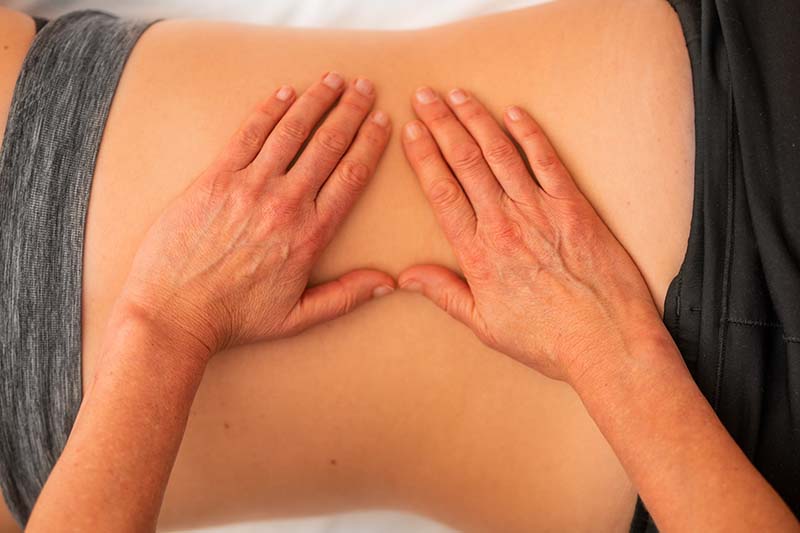A Comprehensive Guide to Managing Acute Low Back Pain

Picture this. You’ve just finished dinner, and you’re reluctantly getting started on the dishes. You bend down to load a plate in the dishwasher and – BAM – it hits. Sharp pain in your lower back, out of nowhere.
It’s so painful you can hardly breathe. The whole area locks up and your back muscles suddenly feel like concrete. It takes every ounce of your strength to gingerly waddle to the couch. Maybe it feels better to sit or lie down. Maybe that only makes it worse.
You take an Advil, and pain goes from a torturous 11/10 down to an excruciating 10.5. ‘What did I do to myself?’ you’re thinking. “Should I go to the E.R.? Should I call my Doctor? Or should I just ride it out?”
Panicked, you query the Internet about your back pain, and begin catastrophizing, rapidly. Within five minutes, Doctor Google has diagnosed you with a muscle strain, a slipped disc, an aortic aneurism, and cancer.
You make an appointment to see your doctor. They prescribe you stronger pain meds, which take the edge off. Maybe you see a chiropractor, a physiotherapist, or an acupuncturist for treatment. Over the course of several weeks, or maybe even months, the pain mercifully subsides and you slowly get back to your life.
Episodes of acute lower back pain are different for everyone, but a few things are consistent in most cases: uncertainty, frustration, and debilitating pain that puts your life on hold.
Today’s article aims to provide a roadmap for managing low back pain. We start by outlining what can cause it. Then we review how to know when it is a sign of something sufficiently sinister to require medical attention. Lastly, referencing the best evidence available, we describe principles to guide your recovery.
What Causes Lower Back Pain?
When people with lower back pain see a healthcare professional, they often want to know what specific biological tissue is causing their lower back pain. Is it a disc herniation? A muscle tear? A joint sprain?
An honest answer begins with the hard reality that anatomically speaking, the lower back (like most parts of the body, when we look under the hood), is anything but simple. The lumbar spine is a claustrophobic mess of bones, muscles, nerves, blood vessels, and connective tissue.
In most episodes of lower back pain, an irritated tissue somewhere within that intricate arrangement of flesh has kicked off the pain response. Sometimes it's an intervertebral disc. Sometimes it’s a facet joint. Sometimes it’s a lumbar nerve root. Sometimes it’s a muscle [1].
Dozens of factors make certain tissues more likely to be the culprit than others.
For instance, a pregnant woman is more likely to have sacroiliac joint pain than a 70-year-old man, because during pregnancy, the ligaments supporting that joint loosen.
On the other hand, an intervertebral disc herniation is more likely in a 40-year-old man than an 80-year-old man, as our discs dry out with age, making them less likely to herniate.
The big question is this: from a treatment perspective, how important is it to know the precise tissue at fault in each case? When does the pain source matter and when does it not?
Does the Source of Pain Drive a Specific Treatment Approach?
It turns out that, with two exceptions, the treatment principles for lower back pain are often very similar, regardless of the pain source. In those exceptional cases, it is extremely important to isolate the source of pain.
Let’s deal with the exceptions first.
Exception 1: Red Flags
Red flags are situations which require immediate medical attention. These are rare, accounting for less than 1% of all episodes of acute low back pain. Nonetheless, it’s worth listing them here – not to scare you – but to educate you on when low back pain might be a sign of something sinister, which warrants a trip to the hospital, or at least your family doctor.
Below are the four main categories of red flags, followed by the signs or symptoms which (along with low back pain) can indicate their presence [2]:
- Malignancy: history of cancer, unexplained or unintentional weight loss, rapid fatigue, fever.
- Fracture: severe pain onset with major trauma, steroid/immunosuppressant use, history of osteoporosis.
- Infection: fever, steroid/immunosuppressant use, intravenous drug abuse, fever/chills with intense pain at night.
- Cauda Equina Syndrome: sudden onset of bowel or bladder dysfunction, perineal numbness, pain down both legs.
Exception 2: Sciatica/Radicular Pain
Sciatica is an old-fashioned word used to describe leg pain emanating from nerves in the low back. Researchers now prefer the term “radicular pain” [3] (radicle means nerve root in Latin). If your lower back pain started in your back, but soon shot down your leg in a thin line which travels below the knee, it’s possible you have an irritated nerve root, which sometimes requires very specific care.
Sometimes, when inflamed, nerves conduct more or different signals than normal, resulting in isolated areas of extreme leg pain, pins and needles, or other weird sensations (like the feeling of water trickling down the leg, or bugs crawling on the skin). Sometimes, when physically compressed and deprived of oxygen, nerves cease to conduct any signals at all, resulting in muscle weakness, reflex loss, or numbness.
Nerve damage is distinct from other causes of lower back pain because it often takes longer to get better on its own [4]. In severe cases where motor or sensory loss is present, the dysfunction can be permanent if whatever is irritating the nerve (such as a herniated disc) isn’t dealt with surgically.
If you have severe pain shooting down your leg, or are experiencing numbness or muscle weakness, it's certainly worth consulting your family doctor or physiotherapist. They can assess the severity of your symptoms, and tell you whether you require immediate medical attention, a referral to a specialist, or are best to wait it out.
Everything Else: The Conundrum of “Nonspecific Low-Back Pain”
If you don’t fit into the exceptional cases, you likely fall into a category that researchers call “nonspecific low back pain.” This doesn’t mean there isn’t a specific cause to your lower back pain, and it doesn’t mean the pain is in your head. It just means that our clinical tests aren’t precise enough to isolate an anatomical cause with a high degree of certainty. Whether it’s a facet joint, a disc, or a muscle strain causing your back pain, sometimes the clinical presentation is very similar, and those structures can’t be differentiated [5].
If that’s counterintuitive, think of it this way: in acute situations, when pain is searing and the patient can hardly move, all clinicians can confidently say is that somewhere among the hodgepodge of muscles, discs, nerves, joints, and ligaments around a certain part of the back, something is irritated.
When Will It Get Better?
Research shows that even with no treatment at all, the majority of patients with non-specific low back pain improve markedly in six weeks and have fully recovered by 12 weeks. For some people, recovery is quicker. For others, it takes longer. For a minority, it becomes chronic. Generally, though, the prognosis is excellent [6] and time itself is the best healer.

Source: https://www.cmaj.ca/content/184/11/E613
Do You Need Imaging?
When a bout of lower back pain strikes, many people suppose they need imaging to figure out what the problem is. They might get an x-ray, and learn their lumbar spine has all sorts of scary-sounding structural changes. They then assume those structural changes account for their current bout of pain. Sensible assumption, right?
The tricky thing about blaming your pain on imaging findings is that as we age, everyone’s joints change to some degree, but most of these changes are poorly associated with pain [7].
Imagine your back pain started on Tuesday, and you get an x-ray on Wednesday showing disc degeneration and annular fissures.
Here’s the issue: according to the literature, you likely would have had the exact same imaging results on the Monday before your back pain episode. Robust research shows that many of the structural changes in the spine that show up on imaging are best thought of as “wrinkles on the inside” - easy scapegoats for pain, but just as common in people without pain.
A 2017 study, for instance, examined 20-year-olds with no history of back pain and found disc degeneration in 37% of them [8]. That number rises with every decade of age and is not a predictor of back pain.
Surprising, yes. But that’s what the research shows.
Am I saying that structural changes don’t matter at all? No. They’re more like the relationship between kindling and fire. You need kindling to make a fire, but it’s not sufficient on its own. To get a fire going, you need some paper, a spark, bigger pieces of wood and plenty of oxygen.
Structural changes are similar as they relate to pain. Maybe you lived with those structural changes for a decade with no issues. But then other factors created the perfect storm: maybe due to gym closures during the pandemic, you're less active than you’ve been in years. Maybe your child is sick, and you're sleeping poorly and have been under immense stress at work. All these factors, the research shows, can influence pain [9].
Here’s a video which offers a helpful analogy for the multifactorial nature of pain:
Specific Management Principles for Non-specific Low Back Pain
As mentioned earlier, most cases of acute lower back pain get better on their own, without any elaborate or specific treatment. While that fact might reassure you somewhat, if you’re in acute pain, the dilemma remains: is there anything you can you do to accelerate your recovery?
Should you stay in bed and rest? Should you stay active? If so, are certain exercises best? What about massages, or a chiropractic adjustment? Do they help?
Should You Take It Easy, or Stay Active?
On the question of rest versus exercise, my rule of thumb is that it’s best to stay as active as you can without making your lower back worse. This is for a few reasons. First, exercise is a powerful analgesic, causing your brain to release natural pain-killers which can provide meaningful relief. Second, exercise helps you preserve mobility and strength so when you come out of your back pain episode, you aren’t a weaker, stiffer version of your previous self. Third, episodes of low back pain often leave people very fearful of movement. Early, gentle exercise helps ease that apprehension.
Which Type of Exercise is Best?
Are there specific exercises that are superior to others? Meta-analyses suggest that on a population level, most forms of exercise (Pilates, core training, barbell lifting, yoga) work equally well [10-14].
The fact that the research hasn’t crowned one form of exercise as king means that your rehab should be oriented around whatever is meaningful to you. If you’re a yogi, modified yoga flows can be your rehab. If you’re a powerlifter, deadlift and squat variations can be your rehab. The important thing with exercise is to ensure that – as with any medicine – the dose is appropriate.
If you’re unsure where to start and how to progress, we recommend seeing a physiotherapist to guide you along the way.
Do I Need Hands-on Treatment?
Hands-on treatments are one option among many to help relieve pain and improve mobility. They’re not, however, strictly necessary. Just about anything can relieve pain. Medication. Meditation. Massage. Acupuncture. Hypnosis. Exercise. A hot bath. A nap. A good laugh with a friend. Fresh air and sunshine. Pain is such a multifactorial experience that it can be influenced by just about anything.
If you like hands-on treatment, and it helps you get through the day, go for it. But don’t feel the need to rely on it in perpetuity.
Bottom Line: Don’t Forget the Basics!
In an attempt to accelerate recovery, it’s tempting to fixate on biomechanical causes of pain, and seek specific exercises or manual therapy techniques to address them. The research suggests, however, that it’s critical to zoom out and address the basic aspects of wellness.
Things like quality sleep, daily sunlight, social connection and stress management all play a massive role in allowing the body to heal. Don’t get so lost in the minutiae of your injury that you forget to prioritize the major pieces of your self-care.
While acute lower back pain can be a frustrating and debilitating experience, there’s good reason for optimism. The human body is extraordinarily resilient. So long as you’re willing to exercise patience, perseverance, and engage in the right dose of meaningful movement, the odds are that the pain will subside, and before long, you’ll be able to return to the activities that you love.
References
[1] Petersen, T., Laslett, M., & Juhl, C. (2017). Clinical classification in low back pain: best-evidence diagnostic rules based on systematic reviews. BMC musculoskeletal disorders, 18, 1-23.
[2] Verhagen, A. P., Downie, A., Popal, N., Maher, C., & Koes, B. W. (2016). Red flags presented in current low back pain guidelines: a review. European Spine Journal, 25, 2788-2802.
[3] Bogduk, N. (2009). On the definitions and physiology of back pain, referred pain, and radicular pain. PAIN®, 147(1-3), 17-19.
[4] Konstantinou, K., Dunn, K. M., Ogollah, R., Lewis, M., van der Windt, D., Hay, E. M., & ATLAS Study Team. (2018). Prognosis of sciatica and back-related leg pain in primary care: the ATLAS cohort. The Spine Journal, 18(6), 1030-1040.
[5] Chiarotto, A., & Koes, B. W. (2022). Nonspecific low back pain. New England Journal of Medicine, 386(18), 1732-1740.
[6] Costa, L. D. C. M., Maher, C. G., Hancock, M. J., McAuley, J. H., Herbert, R. D., & Costa, L. O. (2012). The prognosis of acute and persistent low-back pain: a meta-analysis. Cmaj, 184(11), E613-E624.
[7] Tonosu, J., Oka, H., Higashikawa, A., Okazaki, H., Tanaka, S., & Matsudaira, K. (2017). The associations between magnetic resonance imaging findings and low back pain: A 10-year longitudinal analysis. PLoS One, 12(11), e0188057.
[8] Brinjikji, W., Luetmer, P. H., Comstock, B., Bresnahan, B. W., Chen, L. E., Deyo, R. A., ... & Jarvik, J. G. (2015). Systematic literature review of imaging features of spinal degeneration in asymptomatic populations. American journal of neuroradiology, 36(4), 811-816.
[9] van der Hulst, M., Vollenbroek-Hutten, M. M., & IJzerman, M. J. (2005). A systematic review of sociodemographic, physical, and psychological predictors of multidisciplinary rehabilitation—or, back school treatment outcome in patients with chronic low back pain. Spine, 30(7), 813-825.
[10] Verbrugghe, J., Agten, A., Stevens, S., Hansen, D., Demoulin, C., Eijnde, B. O., ... & Timmermans, A. (2020). High intensity training to treat chronic nonspecific low back pain: Effectiveness of various exercise modes. Journal of Clinical Medicine, 9(8), 2401.
[11] Kim, B., & Yim, J. (2020). Core stability and hip exercises improve physical function and activity in patients with non-specific low back pain: a randomized controlled trial. The Tohoku journal of experimental medicine, 251(3), 193-206.
[12] Eliks, M., Zgorzalewicz-Stachowiak, M., & Zeńczak-Praga, K. (2019). Application of Pilates-based exercises in the treatment of chronic non-specific low back pain: state of the art. Postgraduate medical journal, 95(1119), 41-45.
[13] Demirel, A. Y. N. U. R., Oz, M. Ü. Z. E. Y. Y. E. N., Ozel, Y. A., Cetin, H. A. T. İ. C. E., & Ulger, O. (2019). Stabilization exercise versus yoga exercise in non-specific low back pain: pain, disability, quality of life, performance: a randomized controlled trial. Complementary therapies in clinical practice, 35, 102-108.
[14] Tjøsvoll, S. O., Mork, P. J., Iversen, V. M., Rise, M. B., & Fimland, M. S. (2020). Periodized resistance training for persistent non-specific low back pain: a mixed methods feasibility study. BMC Sports Science, Medicine and Rehabilitation, 12, 1-12.














